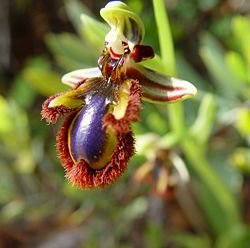
Pseudocopulation
Encyclopedia

Pollinator
A pollinator is the biotic agent that moves pollen from the male anthers of a flower to the female stigma of a flower to accomplish fertilization or syngamy of the female gamete in the ovule of the flower by the male gamete from the pollen grain...
attempting to copulate with a flower
Flower
A flower, sometimes known as a bloom or blossom, is the reproductive structure found in flowering plants . The biological function of a flower is to effect reproduction, usually by providing a mechanism for the union of sperm with eggs...
. Some flowers mimic a potential female mate visually, but the key stimuli are often chemical and tactile. This form of mimicry in plants has been titled Pouyannian mimicry.
Orchids commonly achieve reproduction in this manner, secreting chemicals from glands called osmophores located in the sepal
Sepal
A sepal is a part of the flower of angiosperms . Collectively the sepals form the calyx, which is the outermost whorl of parts that form a flower. Usually green, sepals have the typical function of protecting the petals when the flower is in bud...
s, petal
Petal
Petals are modified leaves that surround the reproductive parts of flowers. They often are brightly colored or unusually shaped to attract pollinators. Together, all of the petals of a flower are called a corolla. Petals are usually accompanied by another set of special leaves called sepals lying...
s, or labellum
Labellum
Labellum is the Latin diminutive of labium, meaning lip. These are anatomical terms used descriptively in biology, for example in Entomology and botany.-Botany:...
, that are indistinguishable from the insect's natural pheromone
Pheromone
A pheromone is a secreted or excreted chemical factor that triggers a social response in members of the same species. Pheromones are chemicals capable of acting outside the body of the secreting individual to impact the behavior of the receiving individual...
s. The pollinator then has a pollinium
Pollinium
Pollinium, or plural pollinia, is a coherent mass of pollen grains in a plant.They are the product of only one anther, but are transferred, during pollination, as a single unit. This is regularly seen in plants such as orchids and many species of milkweeds .Most orchids have waxy pollinia...
attached to its body, which it transfers to the stigma of another flower when if it attempts another 'copulation'. Pollinators are often bee
Bee
Bees are flying insects closely related to wasps and ants, and are known for their role in pollination and for producing honey and beeswax. Bees are a monophyletic lineage within the superfamily Apoidea, presently classified by the unranked taxon name Anthophila...
s and wasp
Wasp
The term wasp is typically defined as any insect of the order Hymenoptera and suborder Apocrita that is neither a bee nor an ant. Almost every pest insect species has at least one wasp species that preys upon it or parasitizes it, making wasps critically important in natural control of their...
s of the order Hymenoptera
Hymenoptera
Hymenoptera is one of the largest orders of insects, comprising the sawflies, wasps, bees and ants. There are over 130,000 recognized species, with many more remaining to be described. The name refers to the heavy wings of the insects, and is derived from the Ancient Greek ὑμήν : membrane and...
, and flies
Fly
True flies are insects of the order Diptera . They possess a pair of wings on the mesothorax and a pair of halteres, derived from the hind wings, on the metathorax...
.
The cost to the pollinating insects might be seen as negligible, but study of Cryptostylis
Cryptostylis
Cryptostylis is a genus of flowering plants from the orchid family, Orchidaceae. It was first defined by the prolific Scottish botanist, Robert Brown in 1810. The type species has since been designated as Cryptostylis erecta. Other species include Cryptostylis hunteriana and Cryptostylis subulata...
(an Australian orchid) pollinators shows that they may waste large amounts of sperm
Sperm
The term sperm is derived from the Greek word sperma and refers to the male reproductive cells. In the types of sexual reproduction known as anisogamy and oogamy, there is a marked difference in the size of the gametes with the smaller one being termed the "male" or sperm cell...
by ejaculating onto the flower. Thus there could be antagonistic coevolution such that pollinators become better at identifying their own species correctly and orchids become better mimics.

External fertilization
External fertilization is a form of fertilization in which a sperm cell is united with an egg cell external to the bodies of the reproducing individuals. In contrast, internal fertilization takes place inside the female after insemination through copulation....
. Frog
Frog
Frogs are amphibians in the order Anura , formerly referred to as Salientia . Most frogs are characterized by a short body, webbed digits , protruding eyes and the absence of a tail...
s provide one such case, with the male releasing sperm as the female discharges her eggs, a process called amplexus
Amplexus
Amplexus is a form of pseudocopulation in which a male amphibian grasps a female with his front legs as part of the mating process...
.
Pseudocopulation is also used as a term to describe behaviours of birds that appear to be copulating but may merely involve mounting and could involve pairs of the same sex.

